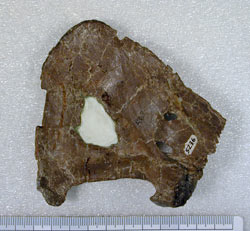Molding
 Once the specimen has been treated, molding can commence. There are a number of different molding techniques and it is important to choose the most suitable one for the specimen in question before beginning work. Molds are generally made in silicone rubber, polyurethane rubber, or latex rubber. Each material has different properties and characteristics. By understanding these materials and techniques, most fossils can be successfully molded without harm.
Once the specimen has been treated, molding can commence. There are a number of different molding techniques and it is important to choose the most suitable one for the specimen in question before beginning work. Molds are generally made in silicone rubber, polyurethane rubber, or latex rubber. Each material has different properties and characteristics. By understanding these materials and techniques, most fossils can be successfully molded without harm.
One-piece poured mold
A one-piece poured mold is generally the simplest to make. The one-piece poured technique is useful for small or partial specimens, such as a single tooth, or a fragment of jaw. This type of mold is good when the specimen is viewed from one side, or is relatively conical. Because any object that is molded must also be removed from the mold, this technique may not be suitable for all small specimens; even with a single tooth it may be necessary to make a more complex mold if it will endanger the specimen to pull it out of a one piece mold.
Two- (or more) part poured molds
For complex or larger specimens, more complex molds are needed. It is necessary to divide the specimen into two or more parts, making each part separately. The goal is to separate the molds so that there is the least possible amount of stress on any part of the specimen
Layered molds
For the largest and/or most complex specimens single or even multi-piece poured molds are not appropriate and it may be best to make a layered mold. These molds can be made in either silicone rubber or in latex rubber. Initially thin layers of molding material are applied in to the specimen in succession to capture surface detail, followed by thicker layers to partially fill in undercuts and provide strength. A layer of gauze or some other fabric is often added for additional strength and flexibility. Layered molds are usually multi-part and are thin-walled; this allows for the flexibility necessary to make demolding easier and less dangerous to the specimen.
Detailed procedures for each of these molding techniques can be found in the Basics of Moldmaking by Marilyn Fox, Preparator at the Peabody Museum of Natural History, Yale University. Download the full document for additional detailed information on the following:
• A one piece poured mold for flat specimens
• A one piece poured mold for small specimens
• Two (or more) part poured molds
• Layered molds
• A five - layer method for silicone molds
• Latex molds
• Jacketing
• Jackets for one-part molds
• Jackets for multi-part molds
Several additional documents are available which give detailed information on molding techniques used by preparators and exhibition specialists at the American Museum of Natural History during the renovation and reinstallation of the vertebrate fossil exhibits in the early 1990’s. These are presented as historical documents although preparators may find some of the information useful.
• Bas-relief molds
• An alternative for silicone pour molds
• Phantom shim technique
• Multi-piece polyester and fiberglass jackets for latex molds
Silicone rubber is one of the more common materials used for molding. Two documents are available with detailed information on silicone.
• Click here to access information on silicone mold life
• Click here for information on de-airing silicone during molding

